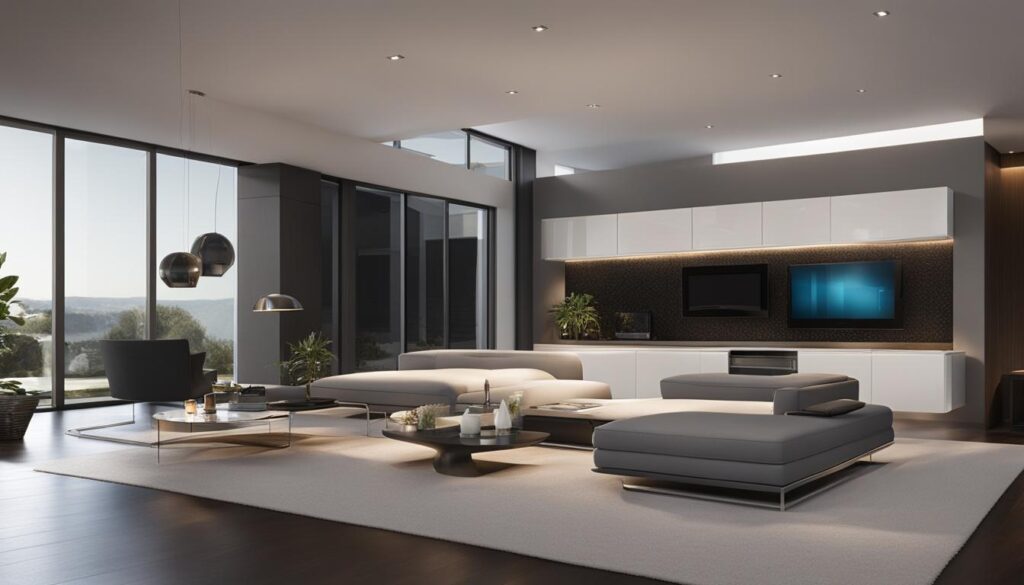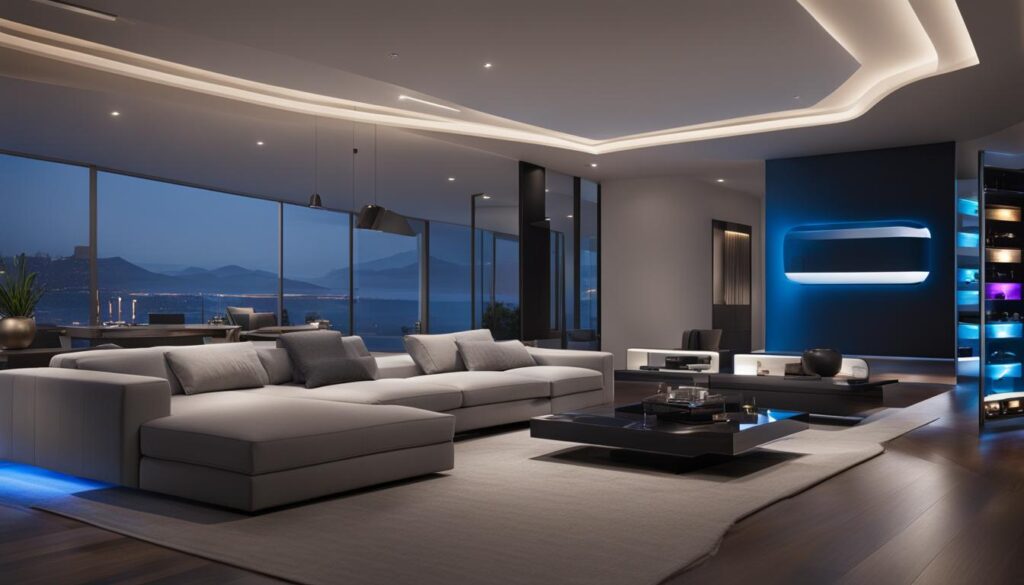Home automation is revolutionizing the way we interact with our homes, offering unparalleled convenience and control over our devices. As technology continues to advance, more and more users are embracing the benefits of home automation systems to simplify their lives. But what is the number one product that users desire to control with home automation?
According to user preferences and popular trends, the top product that users wish to automate in their homes is the lighting system. Controlling the lighting in your home through automation brings a multitude of benefits, ranging from convenience to energy savings.

Key Takeaways:
- The top product users want to automate with home automation is the lighting system.
- Automating the lighting system offers convenience and enhances the ambiance of your home.
- Popular products for automating lighting include smart bulbs, smart switches, and motion sensors.
- When choosing lighting products for home automation, consider compatibility, ease of use, and integration with other smart devices.
- The future of home automation and lighting involves AI integration and energy-efficient solutions.
The Benefits of Automating Lighting in Your Home
Automating the lighting system in your home offers numerous benefits. Firstly, it provides convenience as users can control the lights from anywhere using their smartphones or voice assistants. This means no more fumbling for switches or getting up to turn off lights. Additionally, automating lighting allows users to create custom lighting scenes and schedules, enhancing the atmosphere and mood in different areas of their homes. For example, they can set the lights to gradually dim at bedtime or turn on automatically when they enter a room.
Another significant advantage is the potential for energy savings. With automated lighting, users can ensure that lights are only on when needed, reducing electricity consumption and lowering utility bills.
By integrating smart technology into the lighting system, users can experience the following benefits:
- Convenience: Control your lights from anywhere using your smartphone or voice commands.
- Customization: Create personalized lighting scenes and schedules to enhance the ambiance in different areas of your home.
- Energy savings: Ensure that lights are only on when needed, reducing electricity consumption and lowering utility bills.
Automated lighting not only adds convenience to your daily life but also creates a more energy-efficient and environmentally friendly home. With the ability to control your lights remotely, you can easily turn off forgotten lights or schedule them to turn on and off at specific times, even if you’re not at home. This not only saves you money but also contributes to a greener future.
Automation technology has made significant advancements in recent years, allowing for seamless integration of lighting systems into smart homes. With just a few taps or voice commands, you can transform the ambiance of your home and enjoy the benefits of convenience, customization, and energy savings.
Quoting Smart Home Enthusiast:
“Automating my lighting system has made my life so much easier. I can effortlessly control the lights in every room using my smartphone, create the perfect lighting scenes for different occasions, and save energy by ensuring lights are only on when necessary. It’s truly a game-changer!” – Sarah Thompson, Smart Home Enthusiast
| Benefits of Automating Lighting | |
|---|---|
| Convenience | Easy control from anywhere using your smartphone or voice commands |
| Customization | Create personalized lighting scenes and schedules for different areas |
| Energy Savings | Reduce electricity consumption and lower utility bills |
Popular Products for Automating Lighting
When it comes to home automation, lighting control systems are a popular choice for users looking to enhance their living spaces. With the advancements in technology, there are various products available that can transform your standard lighting into smart and automated systems. Let’s explore some of the popular products:
Smart Bulbs
Smart bulbs are a convenient option for automating lighting in your home. These bulbs can be controlled remotely using a smartphone app or voice commands, allowing you to turn lights on or off, adjust brightness, and even change colors. With customizable features and scheduling options, smart bulbs offer flexibility and the ability to create the perfect ambiance for any occasion.
Smart Switches
If you’re looking for a more permanent solution, smart switches are a great choice. These switches replace traditional light switches and give you the power to control multiple lights or even entire rooms with ease. With smart switches, you can dim the lights, set schedules, and create personalized lighting scenes to suit your preferences.
Motion Sensors
Motion sensors are another popular product for automating lighting in your home. These sensors detect movement and automatically turn lights on or off accordingly. They are especially useful in areas such as hallways, bathrooms, and garages, where lights can be triggered by your presence, providing both convenience and energy efficiency.
These popular products offer a range of features and functionalities to suit different needs and preferences. Whether you opt for smart bulbs, smart switches, or motion sensors, integrating them into your home automation system can bring convenience, energy savings, and enhanced control over your lighting.

Considerations for Choosing Lighting Products for Home Automation
When it comes to selecting lighting products for your home automation system, there are several important factors to consider. These considerations will ensure that you choose the right products that align with your needs and provide a seamless integration into your smart home setup.
Compatibility
One of the most crucial factors to consider is compatibility. Make sure that the lighting products you choose are compatible with your home automation system or voice assistant, such as Amazon Alexa or Google Assistant. Check the product specifications or consult with the manufacturer to ensure seamless compatibility, avoiding any unexpected compatibility issues.
Ease of Use
Another essential consideration is the ease of use. You want lighting products that are easy to set up and control without any technical complications. Look for products that offer intuitive interfaces or smartphone apps that allow you to easily manage and adjust your lighting settings. This will ensure a smooth and user-friendly experience for you and your family.
Integration with Other Smart Devices
Consider the potential for integration with other smart devices and systems in your home. Look for lighting products that can seamlessly integrate with other smart home devices, such as security systems, thermostats, or entertainment systems. This compatibility will allow you to create custom routines or scenes that involve multiple devices working together, enhancing the functionality and convenience of your home automation system.
Lighting Aesthetics, Color Options, and Energy Efficiency
Take into account your specific needs and preferences regarding lighting aesthetics, color options, and energy efficiency. Different lighting products offer various features such as adjustable brightness, color-changing capabilities, and energy-saving options. Consider the ambiance you want to create in each room and the overall energy efficiency of the lighting products you choose.
By considering these factors when choosing lighting products for your home automation system, you can ensure compatibility, ease of use, integration, and ultimately create the perfect lighting experience tailored to your needs.
The Future of Home Automation and Lighting
The future of home automation and lighting is an exciting one, as advancements in technology continue to shape the way we live in smart homes. One of the key trends to look out for is the integration of artificial intelligence (AI) into lighting systems. With AI, users can enjoy a more personalized and intuitive control of their lighting, tailored to their preferences and daily routines. Imagine your lights automatically adjusting based on the time of day, your activities, and even your mood, all thanks to AI.
Energy efficiency is also a top priority in the future of home automation and lighting. LED technology has already revolutionized the lighting industry with its long lifespan and low power consumption. As this technology continues to evolve, we can expect even more energy-efficient lighting solutions to be integrated into our automated systems. Not only will this help reduce our environmental footprint, but it will also result in significant energy savings for homeowners.
Another exciting development on the horizon is the expansion of interoperability standards like Matter. This means that users will have more flexibility when it comes to choosing lighting products and devices for their home automation systems. No longer will you be limited to a single brand or manufacturer. With interoperability standards, you can mix and match products from different brands, ensuring compatibility and easy integration.
As technology advances, the possibilities for home automation and lighting control will continue to expand. From smart switches and bulbs to motion sensors and AI-driven systems, the future holds endless opportunities to create a truly connected and convenient living environment. Get ready to embrace the future of home automation and lighting as it transforms our homes into smarter, more efficient spaces.
FAQ
What is the #1 product that users wish to control with home automation?
The top product that users desire to automate in their homes is the lighting system.
What are the benefits of automating lighting in your home?
Automating lighting offers convenience, customizability, and energy savings. Users can control the lights from anywhere, create custom lighting scenes and schedules, and reduce electricity consumption.
What are some popular products for automating lighting?
Some popular products include smart bulbs, smart switches, and motion sensors. These products allow for remote control, multiple light control, and automatic on/off based on movement.
What considerations should I keep in mind when choosing lighting products for home automation?
It is important to consider compatibility with your chosen home automation system or voice assistant, ease of use, integration with other smart devices, and your specific needs and preferences regarding lighting aesthetics, color options, and energy efficiency.
What does the future hold for home automation and lighting?
The future holds advancements in technology, AI integration for personalized control, improvements in energy-efficient lighting solutions, and the expansion of interoperability standards. These developments will pave the way for more automation and control possibilities in smart homes.




